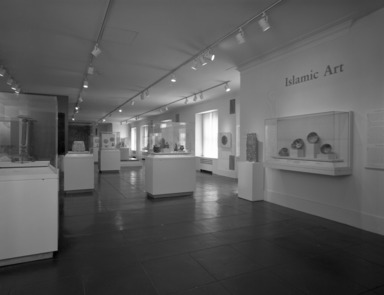
Islamic Art (installation)
DATES May 01, 1991 through 1991 (date unknown)
ORGANIZING DEPARTMENT
Arts of the Islamic World
COLLECTIONS
Arts of the Islamic World
-
May 1, 1991
The reinstalled and refurbished Islamic Gallery at The Brooklyn Museum has just gone on view. It includes a number of new items from the permanent collection, among them several that have never before been on public view, including an exemplary fifteenth-century enameled and gilded glass Syrian mosque lamp and a sixteenth-century Persian leather tooled doublure of a book binding.
The reinstallation has been organized by Layla Diba, Associate Curator of Islamic Art at The Brooklyn Museum, with a view toward exhibiting as wide a range as possible of Islamic art, which spans 1,300 years and ranges geographically from Spain to Southeast Asia. Mrs. Diba has selected examples that represent the many phases in the long development of Islamic art that demonstrate the evolution of the Islamic aesthetic up to the recent past. Both fine and applied arts are included, among them calligraphies, rugs, woven textiles, and ceramics. In the new wall texts, Mrs. Diba details the historical, social, and religious contexts of each object.
All the objects on view illuminate aspects of daily life and religious ritual. Among the additions to the Islamic Gallery are recently acquired gifts and objects in the permanent collection that have not been on view for more than 20 years. They include an octagonal ceramic tile from mid-sixteenth-century Damascus, a ceramic bowl with flaring sides from ninth[-] or tenth[-]century Nishapur, an eighteenth-century Persian prayerbook of ink and gold on paper with a lacquered pasteboard binding and a leather spine, a brass jug inlaid with silver and inscribed in nashk script from fourteenth-century Persia, and an Isfahan wool pile rug from [seventeenth-]century Persia.
Brooklyn Museum Archives. Records of the Department of Public Information. Press releases, 1989 - 1994. 01-06/1991, 083-84.
View Original
